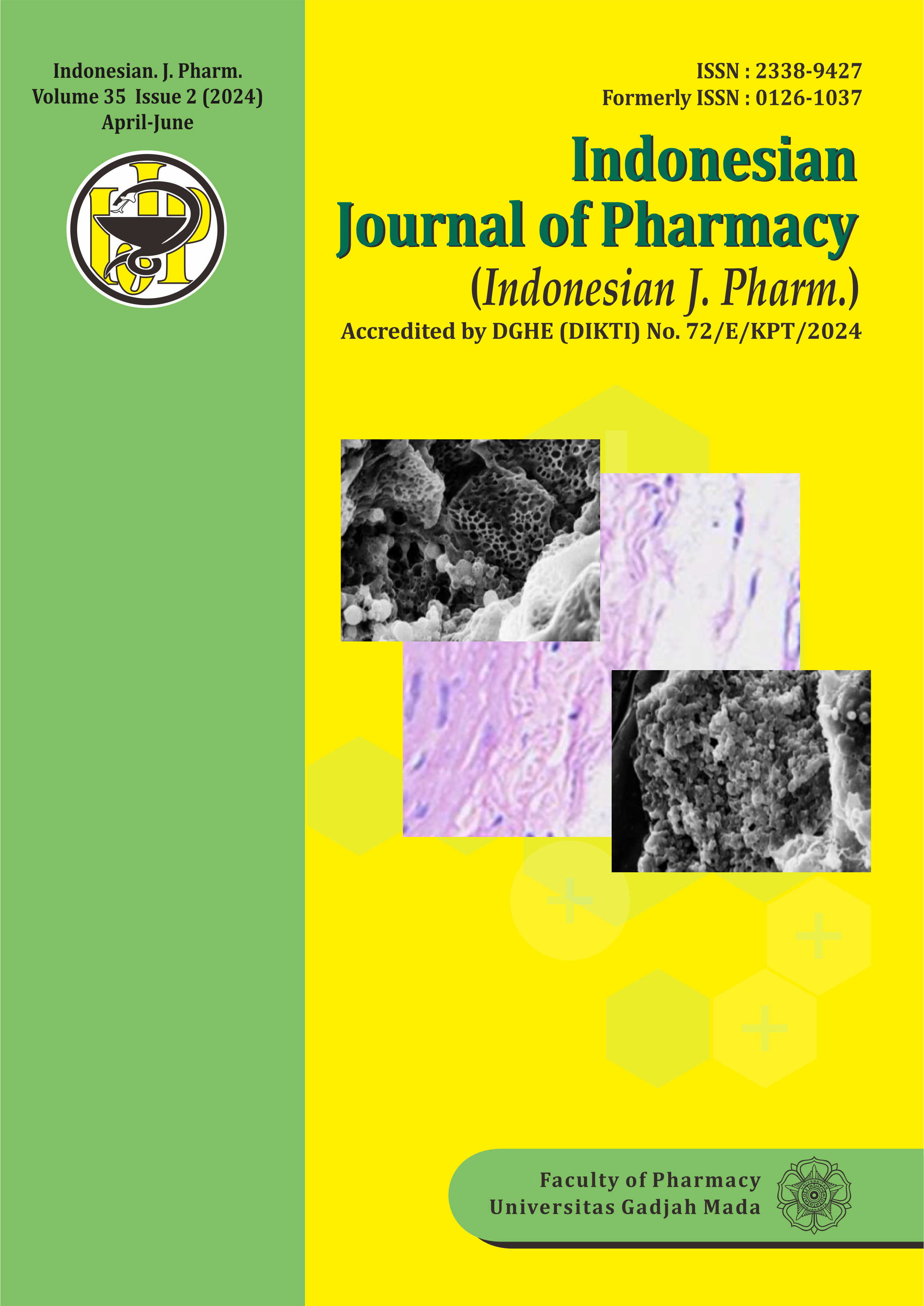An Indonesian Version of The Instrument for Measuring Knowledge and Attitudes Toward Antibiotic Among the Population in The Whole Country
Abstract
To develop a new instrument updated according to the needs of local Indonesian population and to assess its psychometric properties for measuring knowledge and attitudes toward antibiotics. The study was performed with forward and backward translation, an adaptation phase, and validation phase in which we distributed the instrument link via Google Forms to six major regions in Indonesia. Validity was measured using known group validity, construct validity, and Product-moment Correlation. Internal consistency among items was estimated using Cronbach Alpha. Based on the findings in the adaptation phase, additional descriptions (i.e. synonyms or examples) were added to the 6 items. In the validation phase, 1147 participants were recruited. The a priori hypothesis in the known group validity is supported. We also found three items that did not meet construct validity. Based on the results of exploratory factor analysis (EFA) in factor analysis, it is better to use four factors with modified domain names based on items that are incorporated in one factor. Based on the results of the validity test using the product-moment correlation for 11 items in the Attitude domain, all items were declared valid. Cronbach's alpha value in the knowledge domain was 0.791 and in the attitude domain was 0.929. Based on the psychometric analysis, the Indonesian Language Antibiotic Knowledge and Attitude Instrument is a valid and reliable instrument for assessing the level of knowledge and attitudes of the general public toward antibiotics in the Indonesian population.
References
[2] Yam, W.L.Y, Hsu, L.Y, Yap, E.P.H, et al. (2019). Antimicrobial Resistance in the Asia Pacific region; a meeting report. Antimicrobial Resistance and Infection Control; 8: 202, 1-12.
[3] Rather, I.A, Kim, B.C, Bajpai, V.K et al. (2017). Self-medication and antibiotic resistance: Crisis, current challenges, and prevention. Saudi Journal of Biological Sciences; 24, 808-812.
[4] Ventola, C.L. (2015) The Antibiotic Resistance Crisis. Pharm Ther; 40, 277– 283.
[5] Ayukekbong, J.A, Ntemgwa, M, Atabe, A.N. (2017). The Threat of Antimicrobial Resistance in Developing Countries: causes and control strategies. Antimicrobial Resistance and Infection Control; 6:47, 2-8.
[6] Friedman, N.D, Temkin, E, Carmeli, Y. (2016).The negative impact of antibiotic resistance. Clinical Microbiology and Infection; Volume 22, Issue 5, P416-22.
[7] Dadgostar P, Antimicrobial Resistance: Implications and Costs. (2019). Infect Drug Resist; 12 3903–3910.
[8] Karuniawati H, Hassali M.A.A, Suryawati, S et al. (2021) Assessment of Knowledge, Attitude, and Practice of Antibiotic Use among the Population of Boyolali, Indonesia: A Cross-Sectional Study. Int. J. Environ. Res. Public Health; 18, 8258. https:// doi.org/10.3390/ijerph18168258.
[9] Karuniawati H, Hassali M.A.A, Ismail W.I et al. (2021). Antibiotic use in animal husbandry: A mixed-methods study among general community in Boyolali, Indonesia. Int. J. One Health;7(1): 122–127. www.doi.org/10.14202/IJOH.2021.122-127
[10] Permenkes. Tentang Pedoman Umum Penggunaan Antibiotik. (2011). Kementerian Kesehatan Republik Indonesia Nomor 2406/MENKES/PER/XII/2011; Menteri Kesehatan Republik Indonesia: Jakarta, Indonesia.
[11] Michael, C.A, Dominey-Howes D, Labbate M. (2014). The Antimicrobial Resistance Crisis: Causes, Consequences, and Management. Front. Public Health;2:145.
[12] McCullough, A.R, Parekh S, Rathbone J et al. A systematic review of the public’s knowledge and beliefs about antibiotic resistance. J Antimicrob Chemother 2016; 71: 27–33.
[13] Karuniawati, H ,Hassali M.A.A, Suryawati ,S et al. (2020). Public practices towards antibiotics: A qualitative study. Clin Epidemiol Glob Health;8:1277–1281.
[14] Duan L, Liu C, Wang D. (2021). The General Population’s Inappropriate Behaviors and Misunderstanding of Antibiotic Use in China: A Systematic Review and Meta-Analysis. Antibiotics;10, 497.
[15] Jairoun A, Hassan N, Ali A et al. Knowledge, attitude and practice of antibiotic use among university students: A cross-sectional study in UAE. BMC Public Health 2019;19(1): 518. https://doi.org/10.1186/s12889-019-6878-y
[16] Kimberlin, C.L, Winterstein, A.G. (2008). Validity and reliability of measurement instruments used in research. Am. J. Health Syst. Pharm;65:2276-84.
[17] Tiong, T.W, Chua, S.S. (2020). Knowledge and Attitude of University Student on Antibiotic: A Cross-sectional Study in Malaysia. Drug, Health and Patient Safety;12 135-144.
[18] Gorsuch RL. Factor Analysis (2nd ed.). (1983).Hillsdale, NJ: Lawrence Erlbaum Associates.
[19] Krabbe, P.F.M. The Measurement of Health and Health Status: Concepts, Methods, and Applications from a Multidisclipinary Perpective. San Diego, CA: Elsevier/Academic Press.
[20] Beaton, D.E, Bombardier, C, Guillemin, F et al. (2000). Guidelines for the process of cross-cultural adaptation of self-report measures;SPINE Volume 25:24, pp 3186–319.
[21] Andreas, L.M. (2018). Cara Praktis Melakukan Uji Validitas Alat Ukur Penelitian. Gosyen Publishing.
[22] Oh, A.L, Hassali, M.A, Al-Haddad, M.S et al. (2011). Public Knowledge and Attitudes Towards Antibiotic Usage: a Cross-sectional study among the general public in the state of Penang, Malaysia. J Infect Dev Ctries; 5(5):338-347.
[23] Filipetto, F.A, Modi, D.S, Weiss, L.B et al. (2008). Patient knowledge and perception of upper respiratory infections, antibiotic indications and resistance. Patient Preferences and Adherence;2: 35-39.
[24] Parimi N, Pereira, L.M.P, Prabhakar P. (2002). The general public‟ perceptions and use of antimicrobials in Trinidad and Tobago. Pan Am J Public Health; 12 (1).
[25] You, J.H.S, Yau B, Choi, C.T.S et al. (2008). Public Knowledge, Attitudes and Behavior on Antibiotic Use: A Telephone Survey in Hong Kong. Infection;36:153- 157. DOI 10.1007/s15010-007-7214-5
[26] Arifin B, Perwitasari, D.A, Thobari, J.A et al. (2017). Translation, revision, and validation of the diabetes distress scale for Indo- nesian type 2 diabetic outpatients with various types of complications. Value Health Reg Issues;12:63–73. http://dx.doi.org/10.1016/j.vhri.2017.03.0110.








